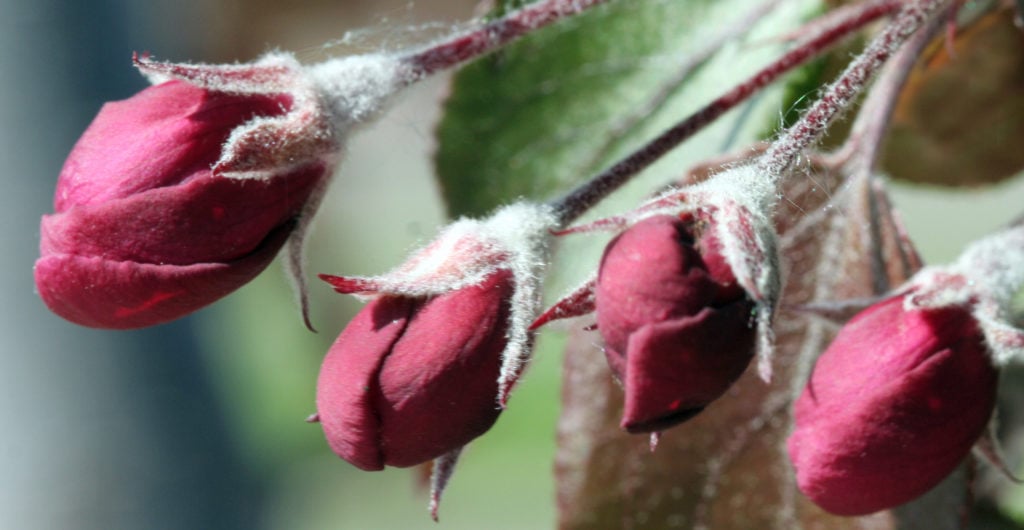Landscape designer, Lauren Dunec Hoang recently posted an article on Houzz with an interesting selection of small-scale trees for patio spaces which I thought you might find useful.
I however strongly disagree with using a Crepe Myrtle in a Patio space. They are in flower in July and attract bees which is not what you want – especially during one of the highest use times for such an outdoor space. Although I like them the fig and citris are not well suited for my area (top of Virginia).
1. Crape Myrtle (Lagerstroemia indica)
Topping Hoang’s list is the Crape Myrtle. While Crape Myrtles need little care to thrive and can tolerate baking heat, I don’t believe the Crape Myrtle is a great choice for a patio space. They flower in July and attract bees which is not what you want – especially during one of the highest use times for such an outdoor space.
2. Crab Apple (Malus spp.)

Flowering Crab Apple, Sharon Mollerus, Flickr. License.
Few ornamental trees offer the variety of tree shapes, sizes, flower colors and ornamental fruit as flowering crabapples. There are over 500 cultivated varieties of crabapples.
Flowering dates range from early April through mid-May. Flower colors may be white, pink to red. Tree height varies from 6 to 50 feet with most in the 15 to 25 feet range. Their variety of growth habit from weeping, spreading, columnar, vase-shaped to pyramidal means many opportunities for their landscape use.
Plant one as a beacon of spring and watch the blossoms cover the tree early in the season in white, all shades of pink and deep plum. In summer and fall, the tree offers decorative clusters of edible fruit as well.
3. Japanese Maple (Acer palmatum)
A longtime favorite for a good reason, Japanese Maples are some of the most stunning small-scale trees around. Leaf colors range from green-gold and bronze to burgundy and fiery red. Prune carefully, or not at all, to maintain the naturally graceful branch structure.
4. Edible Fig (Ficus carica)
Fruit-producing fig trees have long been beloved in Mediterranean courtyards and gardens. Even though I like them in landscape design, the fig is not well suited for the Northern Virginia area.
5. Kousa Dogwood (Cornus kousa)

Kousa Dogwood, Philip McErlean, Flickr. License.
Also called Japanese or Chinese dogwood, these Asian cousins of the familiar native flowering dogwood offer a unique look, and they’re resistant to many of the diseases that frequently plague flowering dogwoods.
Like other types of dogwoods, the spring blossoms are fairly insignificant – it’s the large, creamy leaf bracts around the blossoms that are so distinctive.
Kousa dogwoods have creamy-white to pink, pointed bracts that arrive after the tree has leafed out, giving a deep green backdrop to the star-like blooms.
Kousa dogwoods bloom in the spring about a month after flowering dogwoods. The blooms last about six weeks and gradually fade to pink, giving a long season of color.
6. ‘Bradford’ Callery Pear (Pyrus calleryana ‘Bradford’)
‘Bradford’ Callery Pears were bred to be small-scale, easy-care street trees. Their tidy habit, pretty white blooms in spring and glossy medium-green leaves make them laudable small-space trees. If you plant a ‘Bradford’ Callery pear, be responsible (see the note below) and avoid design mistakes like sticking one in the center of the lawn. Instead, consider a set of four trees to shade a seating area or a pair flanking a pathway.
Note: Although bred to be sterile with other ‘Bradford’ pears, P. calleryana can cross pollinate with other pear varieties planted nearby and produce an invasive offspring. Check with your local nursery before planting and avoid it altogether if your property borders open space.
7. Citrus (Citrus spp.)
Orange, tangerine, lemon, lime, kumquat and other citrus trees offer tasty rewards, but aren’t well suited for Northern Virginia. Citrus thrive in mild climates with well-draining soil and appreciate regular water and doses of organic fertilizer during spring and summer.
8. Saucer Magnolia (Magnolia x soulangeana)
The saucer magnolia is a landscape show-stopper. The stunning early spring blossoms have been said to open “like a thousand porcelain goblets,” and lush summertime leaves are dark green and leathery—adding nice contrast to silvery-gray bark. One of the most popular flowering trees in the United States, the saucer magnolia is also widely planted in Europe.
If you’re in search of a specimen tree or shrub to make a splash in your yard, look no further.
Plus, the wide canopy is a perfect scale for providing shade for an outdoor table.
9. European Hornbeam (Carpinus betulus)
Hornbeams can reach heights up to 45 feet tall if left unchecked; However, they respond so well to pruning that you can train them into practically any form you’d like for your courtyard garden.
10. Palo Verde (Parkinsonia spp.)
Palo verde — Spanish for “green stick” or “green wood” — is named for its bright green trunks and branches. Both species are lovely in courtyards and gardens, offering brilliant spring blooms followed by delicate, small leaves.



Recent Comments